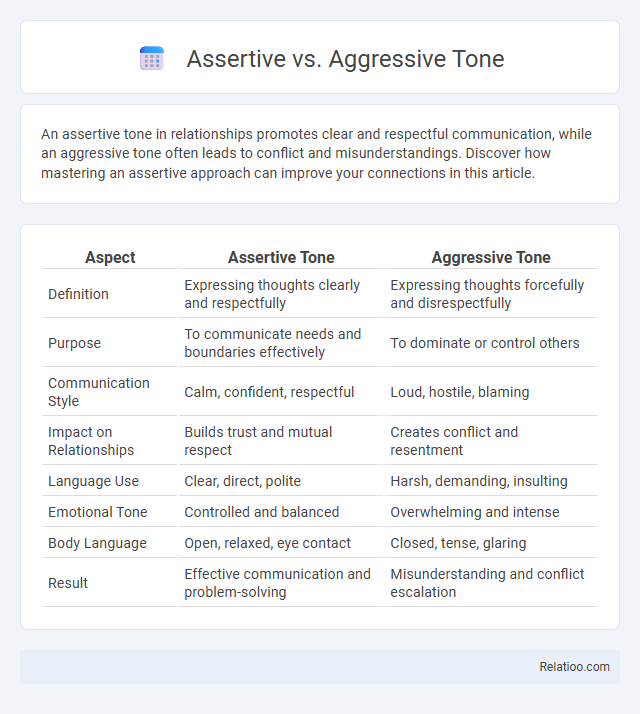An assertive tone in relationships promotes clear and respectful communication, while an aggressive tone often leads to conflict and misunderstandings. Discover how mastering an assertive approach can improve your connections in this article.
Table of Comparison
| Aspect | Assertive Tone | Aggressive Tone |
|---|---|---|
| Definition | Expressing thoughts clearly and respectfully | Expressing thoughts forcefully and disrespectfully |
| Purpose | To communicate needs and boundaries effectively | To dominate or control others |
| Communication Style | Calm, confident, respectful | Loud, hostile, blaming |
| Impact on Relationships | Builds trust and mutual respect | Creates conflict and resentment |
| Language Use | Clear, direct, polite | Harsh, demanding, insulting |
| Emotional Tone | Controlled and balanced | Overwhelming and intense |
| Body Language | Open, relaxed, eye contact | Closed, tense, glaring |
| Result | Effective communication and problem-solving | Misunderstanding and conflict escalation |
Understanding Assertive vs Aggressive Communication
Understanding assertive versus aggressive communication is crucial for effective interpersonal interactions; assertive tone expresses your needs and opinions clearly and respectfully, promoting mutual respect and collaboration. Aggressive tone, however, often involves forceful or hostile language that can alienate others and escalate conflicts. Mastering assertive communication empowers you to maintain boundaries while fostering positive relationships.
Key Characteristics of Assertive Tone
An assertive tone clearly expresses your ideas and feelings while respecting others' viewpoints, promoting open and honest communication. Key characteristics include confidence, clarity, directness, and calmness without hostility or passivity. Using an assertive tone helps you maintain control in conversations and fosters mutual understanding and respect.
Hallmarks of an Aggressive Tone
An aggressive tone is characterized by hostility, dominance, and a confrontational attitude that often intimidates or alienates the listener. Its hallmarks include raised volume, abrupt language, and a lack of empathy, which can escalate conflicts and damage relationships. Understanding the difference between your assertive tone--which communicates confidence and respect--and an aggressive tone is crucial for maintaining effective and positive communication.
Emotional Impact on the Listener
An assertive tone expresses confidence and respect, fostering positive emotional impact by promoting clear communication and mutual understanding. An aggressive tone often triggers defensive reactions, causing emotional distress and alienation in the listener. Tone shapes emotional response by influencing how messages are perceived, making assertiveness key for constructive interactions.
Language Choices: Assertive vs Aggressive
Your language choices determine whether your tone is assertive or aggressive, impacting how your message is received. An assertive tone uses clear, respectful, and confident language that communicates your needs without undermining others, while an aggressive tone employs harsh, confrontational words that can provoke defensiveness or conflict. Mastering assertive language enhances effective communication by balancing firmness with respect, ensuring your voice is heard without alienating your audience.
Benefits of Assertive Communication
Assertive communication promotes clear, respectful expression of your thoughts and needs, enhancing mutual understanding and reducing conflicts. Unlike aggressive tone, which can provoke defensiveness, assertive tone fosters positive relationships and boosts your confidence. Mastering assertive communication empowers you to set boundaries effectively while maintaining empathy and professionalism.
Negative Consequences of Aggressive Communication
Aggressive communication often leads to damaged relationships, heightened conflicts, and decreased trust due to its confrontational and disrespectful nature. Unlike assertive tone, which promotes clear and respectful expression of needs, aggressive tone can provoke defensiveness and emotional distress in listeners. Persistent use of aggressive tone may result in a toxic environment, lowered collaboration, and increased stress levels among individuals or teams.
How to Shift from Aggressive to Assertive Tone
Shifting from an aggressive to an assertive tone involves expressing thoughts and feelings confidently without infringing on others' rights, emphasizing respect and clarity. Techniques include using "I" statements, maintaining calm body language, and actively listening to promote constructive dialogue. This approach fosters positive communication, reduces conflict, and enhances interpersonal relationships in professional and personal settings.
Common Misconceptions about Assertiveness
Common misconceptions about assertiveness often confuse it with aggression or passive behavior, but assertiveness is about expressing your rights and feelings clearly and respectfully without violating others' boundaries. Unlike aggressive tones that demand or threaten, an assertive tone maintains calm confidence and encourages open communication. Understanding these distinctions helps you navigate interactions more effectively, avoiding misinterpretations that may harm relationships.
Practical Examples for Clear Communication
An assertive tone communicates confidence and respect, exemplified by saying, "I would like to share my perspective on this project." An aggressive tone often causes conflict and discomfort, as seen in statements like, "You're wrong, and you need to fix this now." Clear communication relies on an assertive tone to convey needs and opinions effectively without alienating others.

Infographic: Assertive vs Aggressive Tone
 relatioo.com
relatioo.com